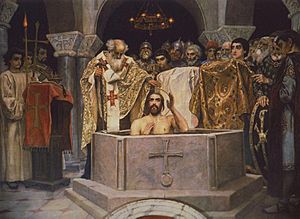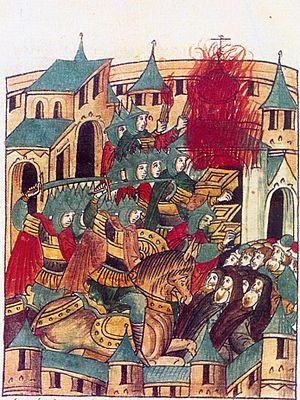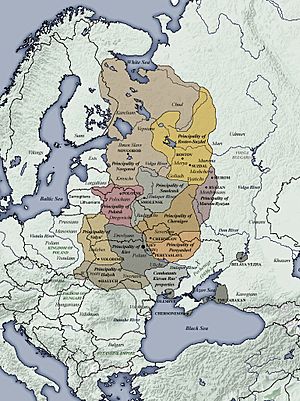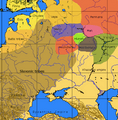Kievan Rus' facts for kids
Quick facts for kids
Kievan Rus'
Русь
|
|
|---|---|
| 882–13th century | |
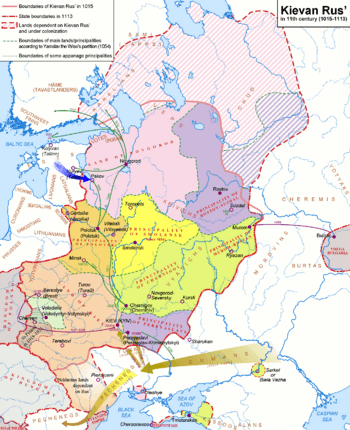
Kievan Rus, 11th century
|
|
| Capital | Kiev |
| Common languages | Old East Slavic |
| Religion | Slavic Paganism Orthodox Christianity |
| Government | Monarchy |
| Grand Prince of Kiev | |
|
• 882–912
|
Oleg |
| Legislature | Veche, Prince Council |
| History | |
|
• Established
|
882 |
|
• Disestablished
|
13th century |
| Currency | grivna |
| ISO 3166 code | RU |
Kievan Rus' (also called Kyivan Rus) was a powerful state in Europe during the Middle Ages. It existed from the late 800s until the mid-1200s. This state broke apart when the Mongol army invaded between 1237 and 1240.
Contents
History of Kievan Rus'
The people who lived in this state called it the "land of the Rus'". The name "Kievan Rus'" became popular in the 1800s. It refers to the time when the city of Kiev (Kyiv) was its main center.
Beginning of the State
The history of Rus' officially began in 882. This is when the capital city was moved from Novgorod to Kiev. This happened after Varangians (who were Vikings) freed Kiev from paying tribute to the Khazars. These Varangians were also known as the Rus people.
According to historical records, the first ruler to unite the East Slavic lands was Prince Oleg. He ruled from 882 to 912.
Golden Age and Expansion
Kievan Rus' became very strong in the mid-1000s. Its lands stretched far and wide. To the south, it reached the Black Sea. To the east, it went to the Volga. To the west, it bordered the Kingdom of Poland and the Grand Duchy of Lithuania.
The time when St. Vladimir (980-1015) and his son Iaroslav the Wise (1019-1054) ruled is known as the Golden Age of Kiev. During this period, the state officially adopted Orthodox Christianity. They also created the first written legal code for Slavic people, called the Russkaya Pravda.
Legacy in Modern Countries
The various East Slavic areas that were once part of Kievan Rus' were later brought together into the Russian Empire in the 1700s. Today, the modern countries of Belarus, Ukraine, and Russia all trace their history and identity back to this early medieval state.
End of Kievan Rus'
Kievan Rus' finally fell apart because of the Mongol invasion of Rus'. This invasion broke the large state into many smaller ones. These smaller states then had to pay tribute to the Golden Horde. This period is sometimes called the Tatar Yoke. In the late 1400s, the Muscovite Grand Dukes started to take over these former Kievan lands. They claimed to be the true successors of Kievan Rus'.
On the western side of Kievan Rus', a new state called the Principality of Galicia-Volhynia emerged. These lands are now part of modern central Ukraine and Belarus. Many Ukrainian historians believe Kievan Rus' was the founding state of Ukraine. This is because the main economic and cultural parts of Rus' were located in what is now Ukraine.
In the northeastern parts of Kievan Rus', traditions continued in the Vladimir-Suzdal Principality. This area slowly became connected with Moscow. Russian historians see Kievan Rus' as the very first period in Russian history.
Images for kids
-
The Invitation of the Varangians by Viktor Vasnetsov. It shows Rurik and his brothers arriving.
-
Princess Olga getting revenge on the Drevlians, from the Radziwiłł Chronicle.
-
A meeting between John I Tzimiskes and Sviatoslav, from the Madrid Skylitzes.
-
Rogneda of Polotsk, Vladimir I of Kiev and Izyaslav of Polotsk.
-
Ivan Eggink's painting shows Vladimir listening to Orthodox priests.
-
The Kingdom of Galicia–Volhynia, one of the states that came after Kievan Rus'.
-
Administering justice in Kievan Rus, by Ivan Bilibin.
-
A Ship burial of a Rus' leader, as described by an Arab traveler.
-
The field of Igor Svyatoslavich's battle with the Polovtsy, by Viktor Vasnetsov.
-
A model of the original Saint Sophia Cathedral in Kiev.
-
Saint Sophia Cathedral in Novgorod, built in the mid-1000s.
-
Part of a map from 1154 by Muhammad al-Idrisi.
See also
 In Spanish: Rus de Kiev para niños
In Spanish: Rus de Kiev para niños


